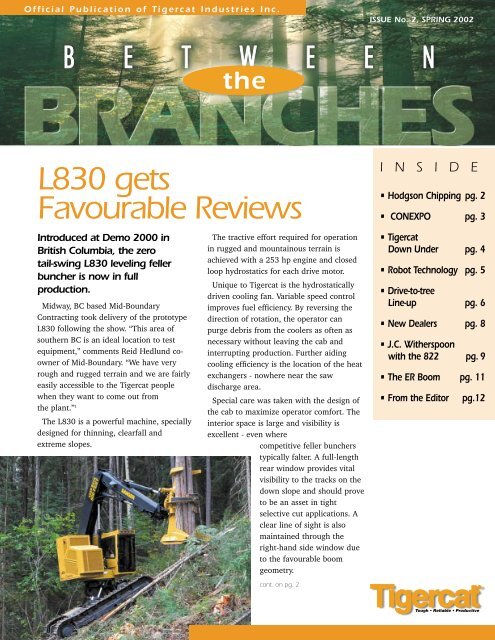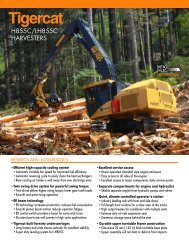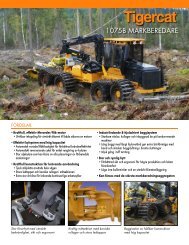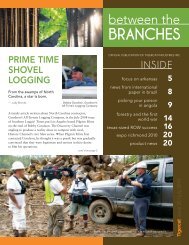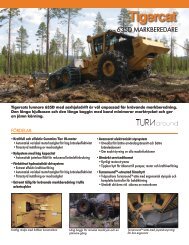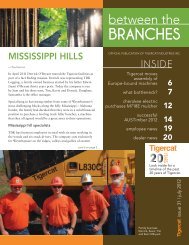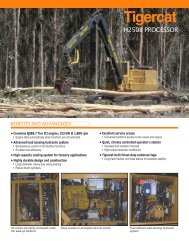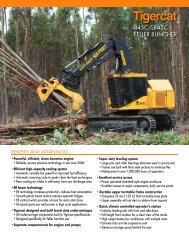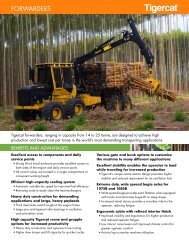Download PDF - Tigercat Industries Inc.
Download PDF - Tigercat Industries Inc.
Download PDF - Tigercat Industries Inc.
You also want an ePaper? Increase the reach of your titles
YUMPU automatically turns print PDFs into web optimized ePapers that Google loves.
Official Publication of <strong>Tigercat</strong> <strong>Industries</strong> <strong>Inc</strong>.<br />
ISSUE No. 2, SPRING 2002<br />
L830 gets<br />
Favourable Reviews<br />
I N S I D E<br />
• Hodgson Chipping pg. 2<br />
• CONEXPO pg. 3<br />
Introduced at Demo 2000 in<br />
British Columbia, the zero<br />
tail-swing L830 leveling feller<br />
buncher is now in full<br />
production.<br />
Midway, BC based Mid-Boundary<br />
Contracting took delivery of the prototype<br />
L830 following the show. “This area of<br />
southern BC is an ideal location to test<br />
equipment,” comments Reid Hedlund coowner<br />
of Mid-Boundary. “We have very<br />
rough and rugged terrain and we are fairly<br />
easily accessible to the <strong>Tigercat</strong> people<br />
when they want to come out from<br />
the plant.” 1<br />
The L830 is a powerful machine, specially<br />
designed for thinning, clearfall and<br />
extreme slopes.<br />
The tractive effort required for operation<br />
in rugged and mountainous terrain is<br />
achieved with a 253 hp engine and closed<br />
loop hydrostatics for each drive motor.<br />
Unique to <strong>Tigercat</strong> is the hydrostatically<br />
driven cooling fan. Variable speed control<br />
improves fuel efficiency. By reversing the<br />
direction of rotation, the operator can<br />
purge debris from the coolers as often as<br />
necessary without leaving the cab and<br />
interrupting production. Further aiding<br />
cooling efficiency is the location of the heat<br />
exchangers - nowhere near the saw<br />
discharge area.<br />
Special care was taken with the design of<br />
the cab to maximize operator comfort. The<br />
interior space is large and visibility is<br />
excellent - even where<br />
competitive feller bunchers<br />
typically falter. A full-length<br />
rear window provides vital<br />
visibility to the tracks on the<br />
down slope and should prove<br />
to be an asset in tight<br />
selective cut applications. A<br />
clear line of sight is also<br />
maintained through the<br />
right-hand side window due<br />
to the favourable boom<br />
geometry.<br />
cont. on pg. 2<br />
• <strong>Tigercat</strong><br />
Down Under pg. 4<br />
• Robot Technology pg. 5<br />
• Drive-to-tree<br />
Line-up pg. 6<br />
• New Dealers pg. 8<br />
• J.C. Witherspoon<br />
with the 822 pg. 9<br />
• The ER Boom pg. 11<br />
• From the Editor<br />
pg.12
cont. from pg. 1<br />
Mid-Boundary operator, Brian Hancock is<br />
thus far impressed with the machine.<br />
“There’s not a lot of fatigue at the end of<br />
the day as the machine is very stable,” he<br />
says. “It is pretty impressive in terms of<br />
smoothness. I think it will definitely be a<br />
front runner.” 2<br />
Hedlund elaborates. “Most leveling<br />
systems are electric and are either open or<br />
closed resulting in jerky movements. With<br />
the [hydraulic controls] you can go<br />
anywhere in between so you have manual<br />
control of the leveling system.” 3<br />
Those who gaze upon the L830 for the<br />
first time seem to be most amazed by the<br />
massive leveling components. The large<br />
diameter pin size and thick steel plate is<br />
unprecedented. Underneath is an FH400<br />
series undercarriage with heavy duty rollers<br />
and track chain. The long track frames<br />
minimize impact on the forest floor by<br />
reducing ground pressure.<br />
“When they designed the 830 they started<br />
with a clean sheet of paper and built a<br />
machine that will be in demand in BC due<br />
to our terrain and forest practices code,” 4<br />
confirms Hedlund.<br />
The L830 engineering team continues<br />
regular communications with Mid-<br />
Boundary, ironing out problems and<br />
working further improvements into the<br />
machine.<br />
1-4 Canadian Forest <strong>Industries</strong>, May 2001<br />
Hodgson Chipping:<br />
First Movers in the Maritimes<br />
It’s all about the payload -<br />
the deciding factor in the<br />
purchase decision.<br />
McKay Hodgson of Truro, Nova Scotia<br />
started his company, Hodgson Chipping,<br />
about 35 years ago as a fifteen person<br />
manual felling crew. The company began to<br />
mechanize in 1987 with the purchase of a<br />
rail delimber.<br />
Within two years a chipper and a pair of<br />
skidders were added. The growth has<br />
continued. These days the Hodgson<br />
Chipping fleet includes 32 pieces of forestry<br />
related equipment.<br />
As a family run business, each member of<br />
the Hodgson clan looks after a different<br />
aspect of the business. McKay and Vaughn<br />
head up daily operations, Dale is<br />
responsible for organizing the trucking,<br />
Paul manages the chipping crew and Roger<br />
leads the harvesting crew.<br />
Hodgson Chipping contracts for Kimberly<br />
Clark, operating primarily in the southwest<br />
region of Nova Scotia. Ground conditions<br />
range from rolling hills to very challenging<br />
rocky terrain. The weekly harvest of 2,500-<br />
3,000 tons is comprised of red spruce, fir<br />
and various hardwoods.<br />
In January 2001, Strongco forestry<br />
salesman, Sandy Hodgson, landed a<br />
<strong>Tigercat</strong> 630B on the jobsite. The preceding<br />
winter produced higher than average snowfall,<br />
leaving the Hodgson’s to deal with<br />
chest deep accumulations. They were<br />
skidding with Deere 648D and 648GII<br />
skidders and were experiencing problems<br />
getting the felled trees to roadside.<br />
2
Traditionally, smaller skidders have been<br />
used in working forests throughout the<br />
Maritimes but the performance advantages<br />
of the larger <strong>Tigercat</strong> 630B became quickly<br />
apparent.<br />
Previously, the tough conditions and<br />
smaller machines restricted operator Paul<br />
Hodgson to skidding single bunches.<br />
Conversely, the smooth hydrostatic drive of<br />
the 630B consistently moved two or three<br />
bunches to roadside with every pull.<br />
When asked why Hodgson Chipping went<br />
out on the proverbial limb and bought the<br />
first <strong>Tigercat</strong> skidder in the Atlantic<br />
provinces, Vaughn answers quickly, “It was<br />
the payload that made the decision to<br />
purchase an easy one.”<br />
The Hodgson’s 630B operates two shifts<br />
daily, amounting to 90-hours per week<br />
including scheduled maintenance. The<br />
machine hauls 900 to 1000 tons per week.<br />
Regarding performance and uptime, Paul<br />
Hodgson comments “The 630B compares to<br />
nothing else, it stands in a class by itself.”<br />
The Hodgson’s have owned a Timberjack<br />
450, Cancar C7, John Deere 648G and CAT<br />
525 in the past. They say that there is no<br />
comparison to the <strong>Tigercat</strong> for comfort and<br />
power. “The <strong>Tigercat</strong> comes out on top in<br />
every way.”<br />
For a skidder that has virtually created its<br />
own market due to its unprecedented size<br />
and capacity, this initial success in the<br />
Maritimes represents another public<br />
perception hurdle. Even in areas where big<br />
skidders have been ignored or frowned<br />
upon, the high production 630B continues<br />
to make inroads.<br />
Between The Branches<br />
Editorial Team:<br />
Tracy Culp<br />
Anthony Goad<br />
Paul Iarocci<br />
Gary Olsen<br />
Please send any<br />
comments to:<br />
comments@tigercat.com<br />
Successful CONEXPO for <strong>Tigercat</strong><br />
Non-forestry machines seen as a natural progression to the <strong>Tigercat</strong> line<br />
In March 2002, <strong>Tigercat</strong> exhibited for the<br />
first time ever at CONEXPO-CON/AGG in Las<br />
Vegas, NV. The T750 street cutter and M760<br />
mulcher, the two machines displayed, could<br />
be viewed as a natural progression of<br />
<strong>Tigercat</strong>’s ever-expanding product line.<br />
Despite being a first-timer at a show of such<br />
magnitude, the <strong>Tigercat</strong> booth was a hub of<br />
activity as tradeshow visitors were attracted<br />
to the innovative niche equipment on display.<br />
The T750 is a prime mover mated to a<br />
street trenching attachment. The machine is<br />
used to open road surfaces prior to the<br />
installation of fiber optic cables, pipes and<br />
other utility infrastructure. The horizontal<br />
drum cutting attachment was developed in<br />
conjunction with <strong>Tigercat</strong>’s strategic partner,<br />
Street <strong>Industries</strong>.<br />
<strong>Tigercat</strong> manufactures the entire machine,<br />
including the attachment and Street<br />
<strong>Industries</strong> oversees the marketing function.<br />
The T750 caught the interest of utility<br />
contractors who see the machine as a<br />
solution to one of the biggest problems with<br />
conventional street opening methods - what<br />
to do with the waste material. Because the<br />
T750 grinds asphalt and reinforced concrete<br />
into a fine aggregate and backfills the trench<br />
as it progresses, there is no need for off-site<br />
disposal.<br />
cont. on pg. 8<br />
The attention grabbing<br />
M760 mulcher.<br />
3
<strong>Tigercat</strong> Down Under<br />
Two years down the track...<br />
<strong>Tigercat</strong> 635 hauling<br />
a load uphill.<br />
Just over two years ago <strong>Tigercat</strong><br />
<strong>Industries</strong>, through newly<br />
appointed dealer Forest Centre<br />
Pty. Ltd., entered the Australian<br />
market...<br />
It was <strong>Tigercat</strong>’s first step outside of North<br />
America. Armed with extensive factory<br />
training and an Australian-based parts<br />
warehouse,<br />
Forest<br />
Centre<br />
went about<br />
finding<br />
their first<br />
<strong>Tigercat</strong><br />
customer.<br />
Initial<br />
single-digit<br />
sales<br />
targets<br />
have long<br />
since been<br />
exceeded<br />
with the<br />
Aussie<br />
machine population soon to edge past the<br />
15 unit mark. The products of<br />
initial focus were the H845B harvester and<br />
the 630B skidder. The 845B feller buncher<br />
mated to the 5700 disc saw and more<br />
recently the 635 skidder added some depth<br />
to the product range.<br />
The H845B machines have all been fitted<br />
with various Waratah harvesting heads for<br />
harvesting or processing of both Eucalyptus<br />
and pinus. Radiata species. This combination<br />
has proven most successful in these<br />
trying conditions where heavy limbs and<br />
tough bark account for most of the<br />
challenge.<br />
Australian loggers’ experiences with<br />
competing purpose-built and excavator<br />
conversion carriers have been unfavourable<br />
when it comes to hydraulic cooling and<br />
performance. In the case of the H845B it’s a<br />
different story. Customers and operators<br />
cannot stop talking about the “lack” of oil<br />
leaks and cool hydraulic oil temperatures -<br />
a welcome change from what they were<br />
previously so accustomed to.<br />
Experienced Tasmanian operator Ricky<br />
Hampson comments, “I have 1,350 hours<br />
on the clock and have not used a single a<br />
wrench on it yet. I came off an excavator<br />
conversion and initially perceived the 845B<br />
as not having enough lift capacity and I<br />
also thought the hydraulic and slewing<br />
speed of the carrier were too slow but as I<br />
settled in, I realized that they were<br />
perfectly matched to suit the head. I am<br />
experiencing less downtime and higher<br />
productivity with the head compared to my<br />
excavator because of this match.”<br />
The H845B has proven to be a winner in<br />
Australia and so it is becoming a popular<br />
and highly productive alternative to what<br />
was formerly available.<br />
The 630B with its reliability and superior<br />
pulling power made a reputation for itself<br />
in no time. First sold into a p. Radiata<br />
operation, the 630B immediately showed its<br />
true (yellow and black) colours, increasing<br />
productivity over conventional single<br />
skidder jobs. Skidding 3-4 trees where other<br />
skidders are only able to pull 1-2<br />
immediately impacts the bottom line,<br />
resulting in happy owners.<br />
Also praised was the 630B’s speed control<br />
lever, which is being used extensively<br />
during road clearing and other blading<br />
operations. Operator Bryan “Bongo” van der<br />
Huel explains, “With a mobile chipper<br />
following the initial logging job, it is my<br />
task to ensure that the road is cleared of all<br />
debris. I am prohibited from damaging the<br />
road surface so I have to be careful about<br />
the setting of my blade. Matching up the<br />
right speed for this operation is just as<br />
critical for me and so with the speed<br />
4
control feature I can set my optimum speed<br />
and give my full attention to the blade<br />
setting which makes for an easier and<br />
neater job overall.”<br />
In Tasmania, where the trees are even<br />
bigger than those in mainland Australia, the<br />
630B created the same stir with its incredible<br />
grapple capacity and pulling power. It<br />
has performed above all expectations.<br />
Anyone who works in this industry knows<br />
that no matter how good the iron is, proper<br />
support and service is essential. With their<br />
Support Plus Programme, Forest Centre has<br />
introduced a system which ensures the<br />
proper schedule of maintenance, oil<br />
sampling and monitoring.<br />
“The program was instigated to aid the<br />
machines owners to get the absolute most<br />
out of their machines, while still working<br />
within the design boundaries,” explains<br />
Service Manager, Glen Marley. “An easy to<br />
follow, detailed check list for each scheduled<br />
service to 4000 hours is incorporated<br />
in the Support Plus Manual. The check<br />
sheets are in triplicate form. The top sheet<br />
is returned to us. The owner retains the<br />
second for his maintenance<br />
records and the<br />
third sheet stays in the<br />
manual to help ensure<br />
maximum resale value<br />
through accurate<br />
service records.”<br />
Every thousand-hour<br />
service includes a full<br />
machine audit free of<br />
charge, conducted by a<br />
factory trained service<br />
technician. The audit is<br />
designed to monitor<br />
maintenance<br />
procedures as well as<br />
machine performance.<br />
The program is free, providing a<br />
profitable, open working relationship<br />
between <strong>Tigercat</strong>, Forest Centre, the<br />
operator, maintenance staff and most<br />
importantly the owner.<br />
This value-added service will go a long<br />
way in seeing that the <strong>Tigercat</strong> products<br />
fulfill their initial promise.<br />
They grow ‘em big down there.<br />
Robot Technology<br />
Anyone who has participated in an admittedly<br />
exhausting <strong>Tigercat</strong> plant tour understands the strength<br />
and depth of <strong>Tigercat</strong>’s manufacturing facilities.<br />
Affiliate fabricators, MacDonald Steel and Metalfab<br />
have recently advanced their technology with three<br />
additional dual robotic welding stations. A total of eight<br />
robotic welding arms in five stations are operating in all<br />
four of the fabricating plants.<br />
The programmable welding robots are enhancing<br />
<strong>Tigercat</strong>’s high standards, while adding speed,<br />
consistency and efficiency.<br />
A 630 skidder front chassis formerly took 18 hours to<br />
weld by hand. The new dual robotic weld centre accomplishes<br />
the same task in a mere eight hours. Amazingly,<br />
the 55% productivity increase is also accompanied by<br />
improved quality.<br />
<strong>Tigercat</strong>’s machining capabilities permit flexibility and<br />
quick modification to prototype work on the fly. It’s all<br />
part of the drive to improve response time to the vast<br />
and continually changing demands of forest professionals<br />
worldwide.<br />
Dual robotic weld station - fast and efficient.<br />
5
The <strong>Tigercat</strong> Drive-to-Tree Buncher<br />
Although predominantly sold in the<br />
southeastern United States, <strong>Tigercat</strong><br />
drive-to-tree feller bunchers are working<br />
in the US northeast, the lake state<br />
regions and even Chile. In northern<br />
Canada, a handful of contractors have<br />
determined that for relatively level<br />
terrain, wheel feller bunchers are a low<br />
cost, effective alternative to track<br />
bunchers.<br />
In the past year, <strong>Tigercat</strong> completely<br />
revamped and reorganized the wheel feller<br />
buncher line-up. Here’s a rundown of what<br />
engineering did and why.<br />
718. Small, simple, quick, maneuverable<br />
165 hp (123 kW)<br />
The primary application of the 718 is<br />
plantation thinning and selective cutting.<br />
The 718 benefits from the shortest wheel<br />
base and the tightest turning radius when<br />
equipped with 28Lx26 or smaller tires.<br />
The 718 is derived from the very popular,<br />
successful and field proven 720 series feller<br />
buncher. Minor hydraulic system refinements<br />
and improved heat rejection capabilities<br />
are the primary differences between the<br />
718 and its predecessor, the 720B.<br />
720D. Powerful, versatile, mid-sized<br />
feller buncher<br />
174-185 hp (130-138 kW)<br />
The extended wheelbase of the 720D<br />
permits the installation of <strong>Tigercat</strong>’s unique<br />
cross-flow cooling system. (See Cross-flow<br />
Cooling sidebar at right)<br />
<strong>Tigercat</strong>’s single range, no-shift transmission<br />
enables the operator to achieve higher<br />
wheel speed in favourable harvesting<br />
conditions without sacrificing tractive effort<br />
if difficult terrain is suddenly encountered.<br />
The 720D has powerful 174 hp Cummins<br />
6BTA5.9 and 185 hp John Deere 6068T<br />
6
Line-up<br />
engine options but retains the feel of a<br />
smaller machine. With a tight turn radius<br />
and excellent rearward visibility, it’s an<br />
excellent choice for contractors requiring<br />
versatility for thinning and final fell<br />
applications.<br />
724D. High production machine,<br />
compact package<br />
200-215 hp (149-160 kW)<br />
Although the 724D has Cummins 6CT8.3<br />
215 hp and John Deere 6081AF 200 hp<br />
engine options and the cross-flow cooling<br />
arrangement, it is all housed in the<br />
visibility-promoting angled rear chassis,<br />
similar to the 720D.<br />
The 724D is a high production final fell<br />
machine offering high stability for tough<br />
terrain. The heavy-duty front chassis, boom<br />
system and 1400 series John Deere front<br />
axle are designed to handle large timber<br />
applications.<br />
Like the 720D, the 724D is equipped with<br />
<strong>Tigercat</strong>’s own single-range transfer case.<br />
726B. Proven production; the machine<br />
that started it all<br />
215 hp (160 kW)<br />
Rounding out the wheel buncher line-up is<br />
the 726 series feller buncher, <strong>Tigercat</strong>’s first<br />
product, introduced in 1992.<br />
Simple, extremely durable design, well<br />
proven construction, excellent stability and<br />
a high capacity fuel tank, position the 726B<br />
as the optimal machine for difficult final<br />
felling applications.<br />
Cross-flow cooling system on a nearly<br />
assembled <strong>Tigercat</strong> skidder.<br />
Cross-Flow Leaves<br />
Engine Fans in the Dust<br />
<strong>Tigercat</strong> is turning to hydrostatically<br />
driven cooling fan systems across a<br />
number of product lines. The fan and<br />
engine are isolated from one another<br />
for improved cooling capacity and a<br />
cleaner engine compartment.<br />
The operator is able to purge the heat<br />
exchangers without exiting the cab,<br />
resulting in less debris build-up. The<br />
positioning of the coolers improves<br />
cooling capacity compared with<br />
standard arrangements because cool<br />
air is blown directly over the coolers<br />
without obstruction.<br />
Thermostat control automates all fan<br />
operations. Variable speed to optimize<br />
fuel efficiency and cold starts;<br />
automatic purge function to keep the<br />
intake area free of debris.<br />
The bottom line? Higher productivity<br />
and longer component life.<br />
With a clear line of sight to the rear, the <strong>Tigercat</strong> 718<br />
is right at home in tight selective cut applications.<br />
The 724D is a large timber<br />
final fell machine.<br />
7
CONEXPO<br />
cont. from pg. 3<br />
Brian Schonberg, President of Street<br />
<strong>Industries</strong> said, “In the initial stages of<br />
development of this product, I knew that it<br />
would create interest at CONEXPO, but I<br />
did not realize that interest would be this<br />
great. We had people from all over the US,<br />
Canada, Europe and even Tahiti inquiring<br />
about it.”<br />
The M760 mulcher, another niche<br />
machine, also attracted heavy interest from<br />
right-of-way and commercial land clearing<br />
contractors. The machine mulches heavy<br />
brush, blow-down, standing trees and<br />
stumps, leaving behind a coarse mulch.<br />
Both the M760 and T750 carriers were<br />
developed from the successful and woodsproven<br />
line of <strong>Tigercat</strong> wheel feller bunchers.<br />
The applications are extremely stressful<br />
on the structure of the carriers. Cooling and<br />
horsepower requirements are significant.<br />
Robin Barker, Product Manager for the<br />
<strong>Tigercat</strong> wheel feller buncher group states<br />
that, “There has been a continual stream of<br />
inquiries about getting a mulching machine<br />
with the quality of our wheel feller buncher.”<br />
Benefits of the M760 include a 425 hp<br />
Caterpillar C-12 engine, variable speed<br />
hydrostatic transmission with a unique<br />
travel speed control lever and a high<br />
capacity cross-flow cooling system.<br />
The M760 also created interest due to its<br />
attachment — the FECON Bull Hog<br />
BH350H. This fixed tooth mulching head<br />
has performance and safety features over<br />
vertical shaft cutters. As land clearing<br />
requirements continue in urban areas<br />
throughout North America, FECON’s<br />
guarded horizontal drum virtually eliminates<br />
the errant spray of debris, instead discharging<br />
directly in the path of the M760.<br />
<strong>Tigercat</strong> sees both the T750 and M760 as<br />
a continuation of its commitment to<br />
producing premium quality products.<br />
“<strong>Tigercat</strong> is approachable for developing<br />
new products based on our existing line of<br />
equipment,” comments Barker. “We have<br />
been successful in our established field<br />
because of our ability to quickly react to<br />
current trends.”<br />
While attracting both new customers and<br />
distributors to the booth, <strong>Tigercat</strong> representatives<br />
were pleased to recognize many old<br />
faces. <strong>Tigercat</strong> President, Anthony Iarocci<br />
said that he was pleasantly surprised to see<br />
“so many of our existing <strong>Tigercat</strong> customers<br />
and dealer people from our forestry<br />
equipment line.”<br />
New Dealerships<br />
The <strong>Tigercat</strong> dealer network is continually expanding. In an<br />
effort to fulfill the demand for <strong>Tigercat</strong> equipment, <strong>Tigercat</strong><br />
<strong>Industries</strong> appointed Vkran, Russia in Moscow and St<br />
Petersburg; JV Arkaim for Asiatic Russia; St. Joseph<br />
Equipment of Duluth, Minnesota; Vines Equipment,<br />
Glenwood, Arkansas; Boman <strong>Industries</strong> based in Salem,<br />
Oregon and Rocan Forestry Service Ltd. for the<br />
province of Newfoundland.<br />
Forestry veterans, Parker Pacific will be distributing<br />
<strong>Tigercat</strong> equipment out of several branches across the British<br />
Columbia mainland and Vancouver Island.<br />
G&S Equipment of Prattville, AL is opening a second store<br />
in Moundville, just south of Tuscaloosa.<br />
Tidewater is opening a new store in Starke, FL.<br />
To learn more about <strong>Tigercat</strong>’s new distributors, visit the<br />
<strong>Tigercat</strong> website at www.tigercat.com and link to the<br />
dealer sites through the <strong>Tigercat</strong> Dealer Locator.<br />
New Ownership<br />
Former Tidewater Branch Manager, Stony Gilmore is<br />
embarking on a new venture as store owner. Stony has purchased<br />
the Tidewater Equipment store in Washington,<br />
Georgia and renamed it ForesTrac Equipment Services <strong>Inc</strong>.<br />
We, at <strong>Tigercat</strong>, wish Stony and his staff all the best and<br />
hope that they will experience continued success as a<br />
<strong>Tigercat</strong> distributor.<br />
ForesTrac Equipment Services <strong>Inc</strong>.<br />
1310 Lexington Rd.<br />
Washington, GA<br />
30673<br />
Phone: (866) 886-5903 or (706) 678-3275<br />
Fax: (706) 678-4803<br />
Email: sgilmore@nu-z.net<br />
Remember to check the <strong>Tigercat</strong> website for the most<br />
up to date products, press releases and dealer contact<br />
information. www.tigercat.com<br />
8
South Carolina Logger Elated with<br />
New <strong>Tigercat</strong> 822 feller buncher Excerpted in part from Timberline Magazine, February, 2002<br />
J. C. ‘Jimmy’ Witherspoon, Jr. logs in eastern<br />
South Carolina. That’s the short of it.<br />
Jimmy owns and runs a large and diverse<br />
logging business and two other enterprises<br />
as well.<br />
The logging company, J.C. Witherspoon Jr.<br />
<strong>Inc</strong>., employs 62 people in a number of<br />
applications including thinning and chipping<br />
plantation pine, harvesting of hardwood<br />
timber and cut-to-length harvesting<br />
of mixed hardwood and softwood stands.<br />
In addition, Witherspoon owns Jimmy’s<br />
Trucking, <strong>Inc</strong>., which provides hauling<br />
services as well as Witherspoon Forest<br />
Products <strong>Inc</strong>., which focuses on buying<br />
timber to be harvested by the logging units.<br />
A busy man, Jimmy sometimes works 100<br />
or more hours per week. The 46-year-old<br />
businessman knows a lot about logging,<br />
having started going to logging sites with<br />
his father when he was just five. His love<br />
for the land and the industry stuck, as he<br />
has been logging full-time for 27 years.<br />
Recently, <strong>Tigercat</strong> <strong>Industries</strong> tapped some<br />
of Jimmy’s substantial expertise in logging.<br />
Ben Twiddy, District Manager for <strong>Tigercat</strong><br />
in South Carolina, said that Jimmy’s<br />
experience with zero-tail swing has made<br />
him a good person to consult about the<br />
design of the new <strong>Tigercat</strong> model 822 feller<br />
buncher. “Jimmy is one of the most mechanically<br />
inclined loggers I know,” said Ben. “I<br />
feel confident if the 822 meets his approval,<br />
it will serve the industry well.”<br />
Jimmy was invited to a <strong>Tigercat</strong> engineering<br />
facility to meet with Grant Somerville<br />
and John Kurelek, the engineers responsible<br />
for designing the 822 feller buncher. The<br />
result of the informal collaboration speaks<br />
for itself. Jimmy now has a prototype 822<br />
feller buncher in service on a thinning job.<br />
He bought the machine from Tidewater<br />
Equipment Co. in Conway, S.C., the same<br />
distributor that sold him some of his other<br />
<strong>Tigercat</strong> equipment. Jimmy’s <strong>Tigercat</strong> 822 is<br />
the first to be put in operation and only the<br />
second one made by the manufacturer.<br />
The new <strong>Tigercat</strong> 822 has met Jimmy’s<br />
highest expectations. “With new products<br />
there’s always a little bit of a learning<br />
curve,” said Jimmy. “Straight out of the<br />
gate, it’s been ready to go. We are tickled to<br />
death with it.”<br />
Jimmy put the <strong>Tigercat</strong> 822 to work with<br />
a crew that conducts thinning and chipping<br />
operations. The machine works in tandem<br />
with a <strong>Tigercat</strong> 720 series feller buncher.<br />
The thinning crew uses the wheel cutter to<br />
make rows. Then the 822 goes to work,<br />
operating in the rows to make select thins.<br />
The operator “can pick and choose trees he<br />
wants,” said Jimmy.<br />
The <strong>Tigercat</strong> 822 is effective in select thins<br />
and cuts because it has good reach. With no<br />
tail swing, it minimizes damage to residual<br />
trees. Zero tail-swing is an important<br />
feature in a machine “whenever space is<br />
real tight,” noted Jimmy. Coupled with its<br />
strong, efficient performance, the new<br />
<strong>Tigercat</strong> 822 is equipped with a host of<br />
amenities and features. Jimmy particularly<br />
noted the machine’s cab. “It is very<br />
spacious, very comfortable, and visibility is<br />
real good,” he said. cont. on pg. 10<br />
Steve Brock operates the<br />
<strong>Tigercat</strong> 822 feller buncher for<br />
J.C. Witherspoon Jr. <strong>Inc</strong>.<br />
9
cont. from pg. 9<br />
<strong>Inc</strong>omparable service access.<br />
“I’ve been rather proud of<br />
the machine,” said Jimmy.<br />
He’s not the only one solid<br />
on the 822. “The operator<br />
made the comment that if I<br />
got rid of the machine, he’d<br />
have to go with it,” said<br />
Jimmy.<br />
The <strong>Tigercat</strong> 822 is<br />
“operator friendly,” according<br />
to Jimmy, and workers can<br />
get acclimated to it quickly and learn how<br />
to use it efficiently. The machine’s [ER]<br />
boom system is the big reason. “Both booms<br />
work off one lever,” explained Jimmy.<br />
The operator can extend and retract the<br />
boom on a horizontal plane by moving one<br />
joystick; joystick controls are ergonomically<br />
positioned in order to minimize operator<br />
fatigue. The boom also reduces energy<br />
consumption because an Energy Recovery<br />
system transfers power between the main<br />
and stick boom functions. <strong>Tigercat</strong> has a<br />
patent pending on the ER boom system.<br />
Jimmy also has an ER boom on his<br />
<strong>Tigercat</strong> 860 feller buncher that the<br />
hardwood crew uses. Running the <strong>Tigercat</strong><br />
860, which is mounted on tracks, Jimmy<br />
got to know the ability of the ER boom well<br />
before he bought the 822.<br />
The hardwood stands are “high graded,”<br />
said Jimmy. Oak and gum are the dominant<br />
species on the hardwood tracts. Logs from<br />
the hardwood stands and mixed stands are<br />
sold to one of several sawmills in the<br />
region. Bark and residue goes to grinders.<br />
Similarly, everything the thinning crew<br />
takes out also becomes a product, whether<br />
it leaves as clean pine chips bound for the<br />
pulp mill or ground waste for boiler fuel.<br />
The logging company produces 400-450<br />
combined truck loads per week of treelength<br />
wood, cut-to-length wood, boiler<br />
fuel and chips. Cut-to-length harvesting<br />
accounts for about 15% of the company’s<br />
production.<br />
Jimmy believes <strong>Tigercat</strong> made a good<br />
move in putting a Sisu engine in the 822<br />
The <strong>Tigercat</strong> 822 with ER boom system quickly reaches out to harvest a tree.<br />
feller buncher. “The fuel economy has been<br />
good,” he said. (According to Ben, <strong>Tigercat</strong><br />
will soon offer buyers a choice of Sisu or<br />
Cummins engines on the 822.)<br />
The 822’s retractable engine house enclosure<br />
gets especially high marks from Jimmy.<br />
It is very important that the cooling system<br />
is “remote mounted” and has a “reverse<br />
fan,” he said, because the arrangement<br />
maximizes the “purging capabilities” of the<br />
engine. Debris tends to flow out and away<br />
from the heat exchangers. The engine is<br />
very easily accessible for service thanks to a<br />
hydraulically operated enclosure.<br />
Jimmy has found in his experience that<br />
the track-mounted <strong>Tigercat</strong> 822 reduces<br />
impact on the forest floor, preventing<br />
compacting and rutting. The debate<br />
between tires versus tracks will probably<br />
continue. Most loggers make a choice based<br />
on the type of substrate they regularly<br />
encounter and the performance they<br />
observe from tires or tracks.<br />
Along with the foundation he has built his<br />
business upon, Jimmy readily adds that his<br />
relationships with others are key to his<br />
success. One thing that has made Jimmy’s<br />
work a bit easier is his relationship with<br />
one of his major equipment suppliers.<br />
“<strong>Tigercat</strong> has been very, very supportive,”<br />
he said.<br />
10
Reflections on the ER Boom<br />
Efficient reach, easy reach,<br />
energy recovery: Set to<br />
revolutionize tree harvesting<br />
<strong>Tigercat</strong> has developed a new boom system called<br />
ER that promises to bring revolutionary improvements<br />
to tree harvesting not seen since the invention<br />
of the high-speed disc saw 20 years ago.<br />
Alberta, Canada has a relatively high concentration<br />
of feller bunchers equipped with ER booms. Three<br />
contractors offer their opinions and findings. Their<br />
machines have been thoroughly tested, having spent<br />
the winter months in double shift operation.<br />
Some background... Conventional boom systems<br />
are fundamentally inefficient at tree felling because<br />
two arcing motion functions must be mixed to<br />
achieve the desired reaching motion. (View a short<br />
animated movie at www.tigercat.com, illustrating this)<br />
Conversely, the patent pending ER boom system<br />
allows the machine operator to extend and retract<br />
the boom on a horizontal plane smoothly and<br />
quickly using a single joystick. The stick boom or<br />
“reach” joystick controls both the main and stick<br />
booms simultaneously, resulting in the attachment<br />
moving either away from or toward the operator.<br />
Fred Frolov, owner of Lov Logging in Plamondon,<br />
AB elaborates. “Picture a machine that is controlled<br />
with a virtual glove rather than joysticks. You reach<br />
your arm out and grab the tree. This machine is as<br />
close to that as we can get at this time. The interface<br />
between operator and machine, using one<br />
joystick, is excellent.”<br />
The main boom and tilt functions operate in the<br />
traditional manner to adjust the height and angle of<br />
the attachment.<br />
Important advantages of the ER boom system<br />
include improved fuel efficiency, increased production<br />
and reduced operator fatigue. Training new<br />
operators should prove a far less daunting task.<br />
“The operator no longer has the mentally tiring<br />
job of simultaneously working the boom and stick<br />
controls to manipulate the attachment in and out in<br />
a smooth manner, “ comments Grant Somerville,<br />
head of <strong>Tigercat</strong>’s track carrier engineering group.<br />
“We have been testing the ER boom for over a<br />
year now and find the operators adapt almost<br />
immediately to the ER, even in cases where we<br />
hadn’t explained to them that the boom operates<br />
differently.”<br />
Felix Tchir, owner of Tchir Forest Products in Lac<br />
La Biche, AB purchased an 860 ER in January 2002.<br />
“This is the tool for training new operators,” says<br />
Felix. “The training period will be shortened and<br />
damage minimized.”<br />
Key to the technology is reduced energy consumption.<br />
The ER system transfers energy back and forth<br />
between the main and the stick boom functions,<br />
reducing the total energy needed to move the boom<br />
system. This translates to reduced demands for<br />
power, pump flow and system cooling.<br />
Operators who have spent time on ER machines<br />
comment on the speed, ease of operation and<br />
smoothness of the boom as well as the extra<br />
horsepower available for other functions and faster<br />
saw recovery.<br />
“Best thing since sliced bread,” quips Terry Corey<br />
of Crater Enterprises in Grande Cache, AB. Terry<br />
has rotated all of his operators in the machine. All<br />
have commented that at the end of the day, they<br />
feel better.<br />
Terry theorizes that the ER boom has improved<br />
saw performance because it achieves a more<br />
parallel cut. “The boom does not arc up or down<br />
and load or bind the saw blade,” says Terry.<br />
“Give someone five minutes on an ER felling<br />
machine and he will never again choose a conventional<br />
one,” says John Kurelek, veteran forestry<br />
equipment<br />
designer. “We<br />
old time logging<br />
machine<br />
designers now<br />
have to apologize<br />
to loggers.<br />
For lack of this<br />
innovation, we<br />
have kept them<br />
using energy<br />
wasteful and<br />
difficult to run<br />
booms.”<br />
An 860 feller buncher<br />
equipped with the ER boom<br />
and 5400 felling saw.<br />
11
Editorial<br />
The patent is a complicated issue. We all know the<br />
value of the patent. Simply put, patents encourage innovation<br />
by rewarding the hardworking inventor or expensive<br />
R&D effort with a financial incentive - some future<br />
protection against interlopers if you will.<br />
On the other hand, patents have gotten some negative<br />
press in the past few years, especially with respect to the<br />
drug companies. To the consumer, prescription prices<br />
often seem wildly inflated. It’s difficult to distinguish<br />
whether drug companies are taking advantage of the law<br />
or using the law as it was intended to recoup the great<br />
cost and risk involved in developing and marketing<br />
new drugs.<br />
<strong>Tigercat</strong> holds a number of patents and currently has<br />
patents pending as well. Big players in our market - in<br />
any market - will try to work around patents to get a<br />
piece of the action. Some might argue that this is good<br />
for the consumer because its prevents monopoly pricing<br />
and encourages competition. Unfortunately, it also discourages<br />
innovation. This is not good for the consumer.<br />
<strong>Tigercat</strong>’s first experiences with patents concerned the<br />
bunching shear, initially released in 1994. Later, the<br />
<strong>Tigercat</strong> 5000 and 5600 bunching saws were based on a<br />
similar concept.<br />
<strong>Tigercat</strong> bunching saws and shears accumulate trees in<br />
parallel alignment in an offset pocket. This patented<br />
designed was quickly copied by several of our<br />
competitors.<br />
According to <strong>Tigercat</strong> Attachment Product Manager,<br />
Duane Barlow, “Some of our competitors, losing market<br />
share due to the superiority of <strong>Tigercat</strong>’s design,<br />
proceeded to copy it - even to the point of incorporating<br />
reinforcement plates added by <strong>Tigercat</strong> due to a drawing<br />
detailing error.”<br />
No great disservice was done to the logging community,<br />
right? Now the logger could get the best type of felling<br />
head on the feller buncher make of his choice. But<br />
wait...<br />
What our competitors did was wrong with respect to<br />
patent law. The competitors subsequently were<br />
compelled to change the design of the copies to<br />
maneuver around the patent.<br />
One of the companies in question now claims that this<br />
modification is a design feature, meant to improve accumulating<br />
ability. We’ve heard otherwise from the field.<br />
Unfortunately, if the “knock-off” felling head is<br />
purchased, not only is the customer receiving an inferior<br />
product, but because it is assumed that the two competing<br />
heads are virtually the same, (they look very similar)<br />
it actually ruins the reputation of the <strong>Tigercat</strong> head that<br />
works correctly.<br />
It should be noted that the inventor of this felling head<br />
design has been performing pioneering work in the<br />
forestry equipment industry for over 50 years. Further<br />
note that our competitors had struggled with the problem<br />
of achieving good bunching properties for years.<br />
<strong>Tigercat</strong> came on the scene in the early nineties and<br />
accomplished in a few years what no one else had<br />
figured out in twenty.<br />
Another interesting observation is how drive-to-tree<br />
feller bunchers made by different manufacturers have<br />
grown to look so similar over the past five years. The<br />
<strong>Tigercat</strong> feller buncher that once stuck out like a sore<br />
thumb at southeast US logging equipment shows now<br />
shares a surprising number of design features with<br />
competitive machines. Who set the standard? Who<br />
subsequently conformed to it?<br />
To conclude, <strong>Tigercat</strong> has another innovative new<br />
product development in its stable along with the accompanying<br />
patents pending. In this Between the Branches<br />
issue, you will read about how the ER boom is improving<br />
productivity and reducing fuel consumption. How<br />
long will it be before the competition picks up on this<br />
development?<br />
I suppose it depends on how much of a threat to track<br />
feller buncher market share ‘ER’ is perceived to be.<br />
Feedback thus far indicates that the ER boom may be the<br />
most significant innovation to hit the forestry equipment<br />
industry since the advent of the high-speed disc saw.<br />
Time will tell...<br />
<strong>Tigercat</strong> patents:<br />
US 5,697,412<br />
5,794,674<br />
5,931,210<br />
6,152,201<br />
6,196,106<br />
6,363,980<br />
CAN 2,143,155<br />
2,209,063<br />
2,090,319<br />
- Paul Iarocci, Editor<br />
Letters to the Editor:<br />
E-mail: comments@tigercat.com<br />
Internet: www.tigercat.com<br />
Tel: (519) 442-1000<br />
Mail: 40 Consolidated Drive, P.O. Box 544, Paris, ON Canada, N3L 3T6<br />
12


